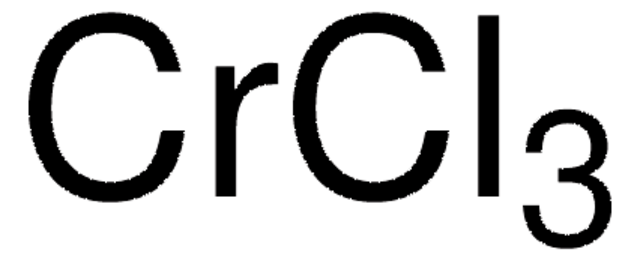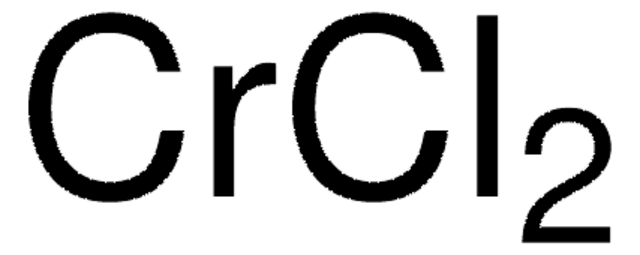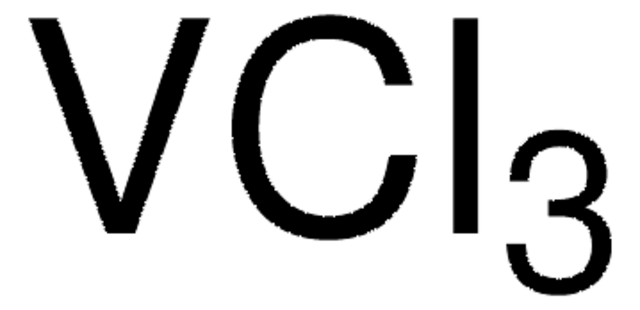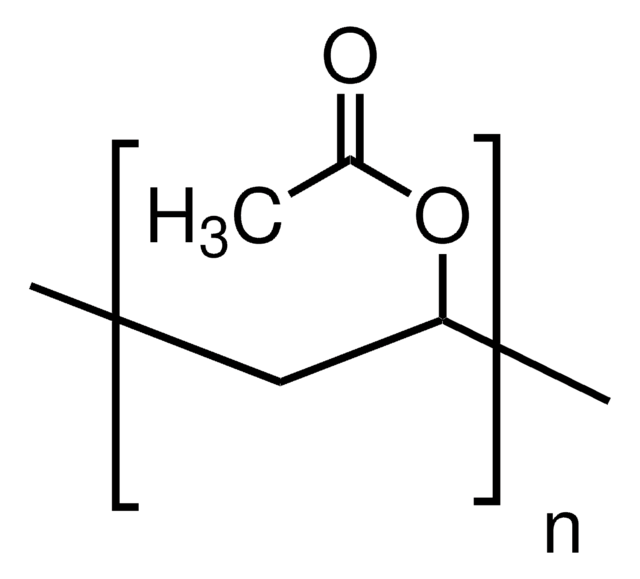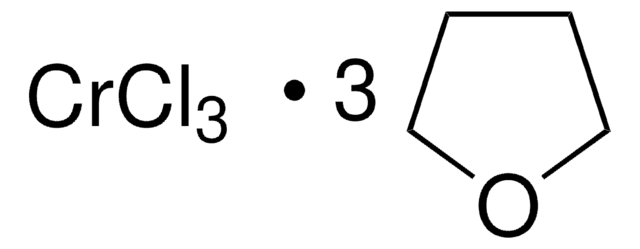200050
Chromium(III) chloride
purified by sublimation, 99%
Synonym(s):
Chromic chloride, Chromium trichloride
Sign Into View Organizational & Contract Pricing
All Photos(3)
About This Item
Linear Formula:
CrCl3
CAS Number:
Molecular Weight:
158.36
EC Number:
MDL number:
UNSPSC Code:
12352302
PubChem Substance ID:
NACRES:
NA.23
Assay:
99%
form:
flakes
Recommended Products
Quality Level
Assay
99%
form
flakes
purified by
sublimation
reaction suitability
reagent type: catalyst
core: chromium
impurities
<0.2% water
density
2.87 g/mL at 25 °C (lit.)
SMILES string
Cl[Cr](Cl)Cl
InChI
1S/3ClH.Cr/h3*1H;/q;;;+3/p-3
InChI key
QSWDMMVNRMROPK-UHFFFAOYSA-K
Looking for similar products? Visit Product Comparison Guide
Application
Chromium(III) chloride can be used in the formation of a catalytic system for the conversion of glucose into 5-hydroxymethylfurfural (HMF). It can also be used in the preparation of ionic liquid mixtures using choline chloride and water with improved ion mobility and conductivity.
The vapor-phase co-reductions with other metal halides by hydrogen results in finely divided intermetallics with applications as structural materials or compounds with useful thermoelectric, magnetic, and oxidation-resistance properties.2
Signal Word
Warning
Hazard Statements
Precautionary Statements
Hazard Classifications
Acute Tox. 4 Oral - Aquatic Chronic 2 - Met. Corr. 1 - Skin Sens. 1B
Storage Class Code
8B - Non-combustible corrosive hazardous materials
WGK
WGK 1
Flash Point(F)
Not applicable
Flash Point(C)
Not applicable
Personal Protective Equipment
dust mask type N95 (US), Eyeshields, Gloves
Choose from one of the most recent versions:
Already Own This Product?
Find documentation for the products that you have recently purchased in the Document Library.
Physicochemical properties of ionic liquid mixtures containing choline chloride, chromium (III) chloride and water: effects of temperature and water content
Protsenko VS, et al.
Ionics, 23(3), 637-643 (2017)
J W Boclair et al.
Chemistry of materials : a publication of the American Chemical Society, 11(2), 303-307 (2001-09-07)
Solutions containing divalent metal [M(II) = Mg2+, Zn2+, Co2+, Ni2+, Mn2+] chlorides and CrCl3 6H2O were titrated with NaOH to yield, for M(II) = Zn, Co, and Ni, hydrotalcite-like layered double hydroxides (LDHs), [[M(II)]1-z[Cr(III)]z(OH)2][Cl]z yH2O, in a single step, without
M B Hansen et al.
Contact dermatitis, 49(4), 206-212 (2004-03-05)
Most studies investigating chromium allergy have been performed with Cr(VI). However, real exposure to chromium from leather products includes both Cr(III) and Cr(VI). We have determined and compared the minimum elicitation threshold (MET) concentration for Cr(III) and Cr(VI) in Cr(VI)-sensitive
Efficient conversion of glucose into 5-hydroxymethylfurfural by chromium (III) chloride in inexpensive ionic liquid
Hu L, et al.
Industrial & Engineering Chemistry Research, 51(3), 1099-1104 (2012)
M A Sipowicz et al.
Toxicology letters, 93(1), 9-14 (1998-02-12)
The tissue levels of chromium were followed after single intraperitoneal or subcutaneous injection of 1 mmol CrCl3/kg body wt. in Swiss male mice. Blood levels were similar after both treatment modes, with half-lives of 31-41 h. Organs not directly exposed
Our team of scientists has experience in all areas of research including Life Science, Material Science, Chemical Synthesis, Chromatography, Analytical and many others.
Contact Technical Service
